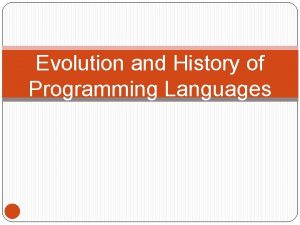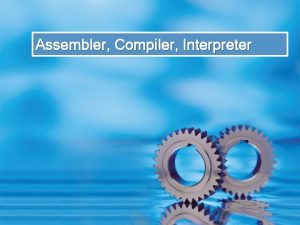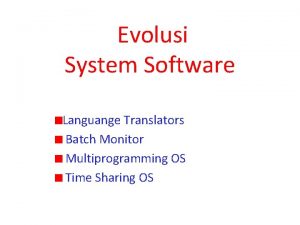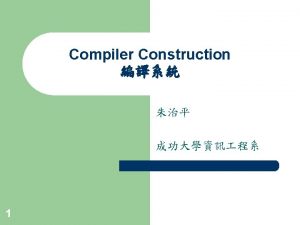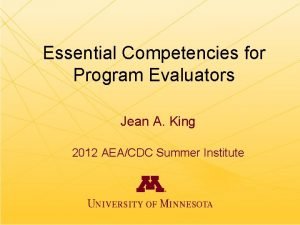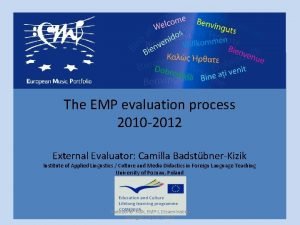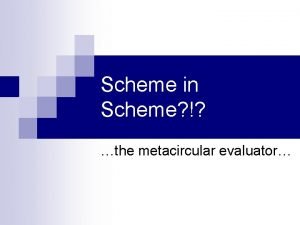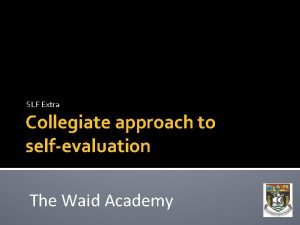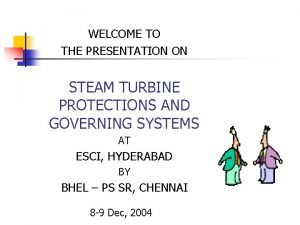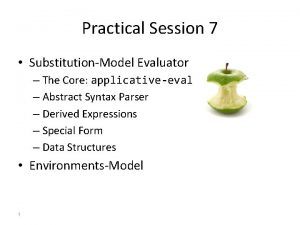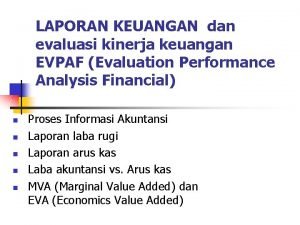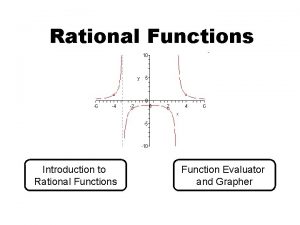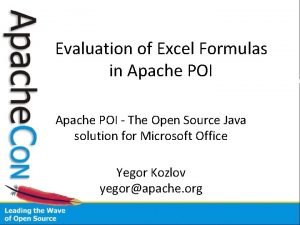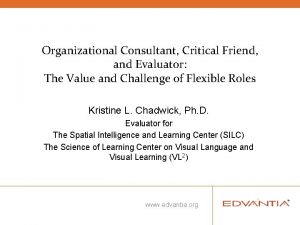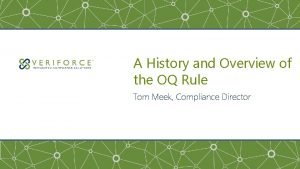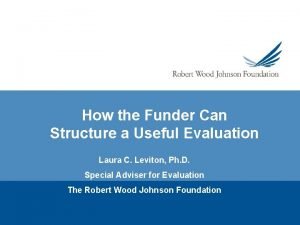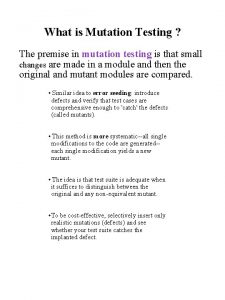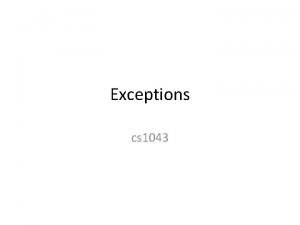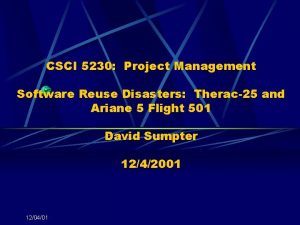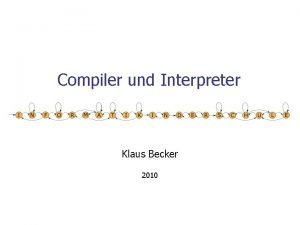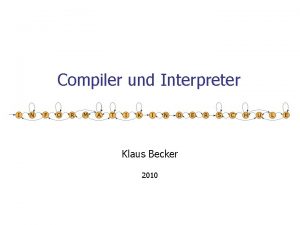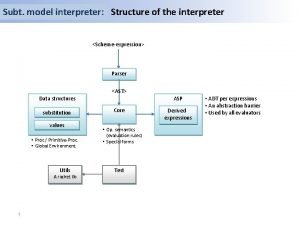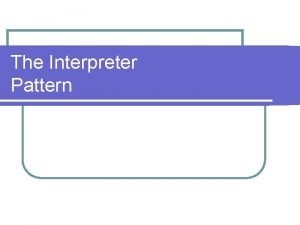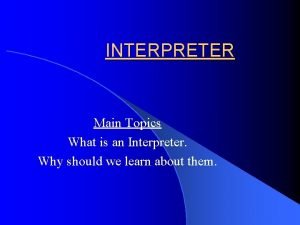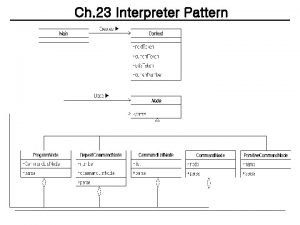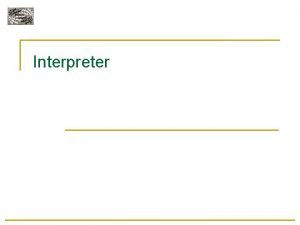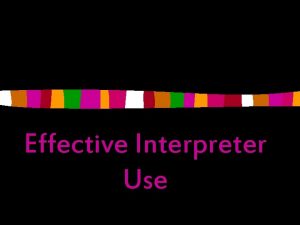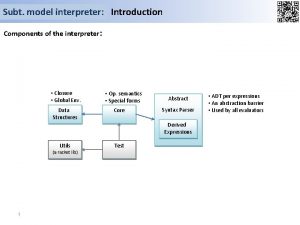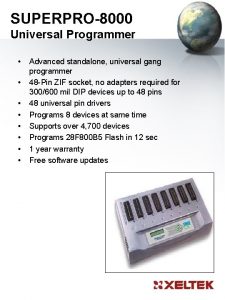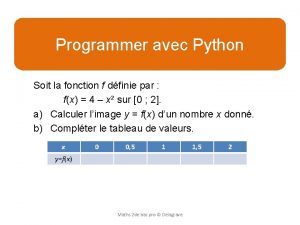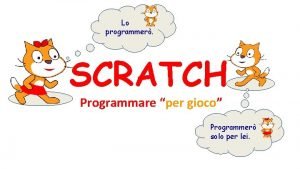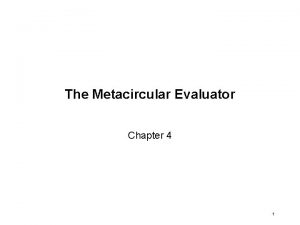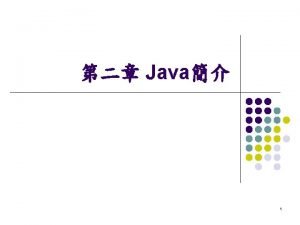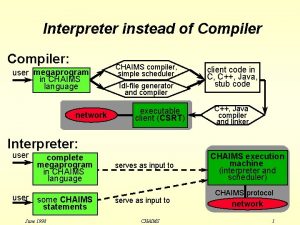The Evaluator 1 Compiler vs Interpreter The Programmer
















![(square 4) | GE x: 10 square: GE *: #[prim] parameters: x body: (* (square 4) | GE x: 10 square: GE *: #[prim] parameters: x body: (*](https://slidetodoc.com/presentation_image_h2/a91ec154edb4099412fbc2fadbb26d4e/image-17.jpg)









- Slides: 26

The Evaluator 1

Compiler vs. Interpreter The Programmer The Computer Transformation Program in High Level Language T Command Processing Unit Program in Low Level Machine Language 2

A Compiler Inputs High Level Program C Machine Level Program The Compiler turns the high CPU level program instructions to Instructions understood by the machine. Outputs 3

An Interpreter Inputs I High Level Program CPU Outputs The Interpreter is a machine level program, which interprets and executes the high level program line after line… 4

The Metacircular Evaluator Inputs Scheme Program ME CPU Outputs The Metacircular Evaluator is an Interpreter for Scheme on a machine whose machine language is Scheme. 5

Evaluator Packages: Core (Evaluation Rules) Abstract Syntax Parser Data Structures First, we introduce the environment model for evaluation of expressions! To be implemented in the Core 6

The Environments Model Substitution model: a single global environment Environment Table Name score Value 23 Environments model: many environments. Generalizes the substitution model. 7

Frame: a table of bindings • Binding: Example: A a pairing of a name and a value x is bound to 15 in frame A y is bound to (1 2) in frame A the value of the variable x in frame A is 15 x: 15 y: 1 2 8

Environment: a sequence of frames • Environment E 1 consists of frames A and B • Environment E 2 consists of frame B only • A frame may be shared by multiple environments B z: 10 E 2 A E 1 this arrow is called the enclosing environment pointer x: 15 y: 1 2 9

Evaluation in the environment model • All evaluations occur in an environment • The current environment changes when the interpreter applies a procedure • The top environment is called the global environment (GE) • Only the GE has no enclosing environment 10

The Environment Model • A precise, completely mechanical, description of: • name-rule looking up the value of a variable • define-rule creating a new definition of a var • lambda-rule creating a procedure • application rule applying a procedure • Enables analyzing arbitrary scheme code, including (when we get there) imperative programming • Basis for implementing a scheme interpreter • for now: draw EM state with boxes and pointers • later on: implement with code 11

Name-rule • A name X evaluated in environment E gives the value of X in the first frame of E where X is bound • z | GE ==> 10 z | E 1 ==> 10 x | E 1 ==> 15 • In E 1, the binding of x in frame A shadows the binding of x in B B GE A E 1 • x | z: 10 x: 3 GE ==> 3 x: 15 y: 1 2 12

Define-rule • A define special form evaluated in environment E creates or replaces a binding in the first frame of E (define z 20) | B z: 10 x: 3 z: 20 A x: 15 y: z: 25 GE E 1 (define z 25) | GE 1 2 E 1 13

Double bubble: how to draw a procedure (lambda (x) (* x x)) t prin l l eva bda-ru lam #[proc-. . . ] e A compound proc that squares its argument Environment pointer Code pointer parameters: x body: (* x x) 14

Lambda-rule • A lambda special form evaluated in environment E creates a procedure whose environment pointer points to E (define square (lambda (x) (* x x))) | E 1 B A E 1 z: 10 x: 3 x: 15 square: Evaluating a lambda actually returns a pointer to the parameters: procedure object x body: (* x x) environment pointer points to frame A because the lambda was evaluated in E 1 and E 1 A 15

To apply a compound procedure P to arguments (Application Rule) 1. Create a new frame A 2. Make A into an environment E: A's enclosing environment pointer goes to the same frame as the environment pointer of P 3. In A, bind the parameters of P to the argument values 4. Evaluate the body of P with E as the current environment We recommend you memorize these four steps 16
![square 4 GE x 10 square GE prim parameters x body (square 4) | GE x: 10 square: GE *: #[prim] parameters: x body: (*](https://slidetodoc.com/presentation_image_h2/a91ec154edb4099412fbc2fadbb26d4e/image-17.jpg)
(square 4) | GE x: 10 square: GE *: #[prim] parameters: x body: (* x x) A x: 4 E 1 square | (* x x) | * | E 1 GE E 1 ==> ==> 16 frame becomes inaccessible x | E 1 ==> 4 17

Example: inc-square GE inc-square: p: x b: (* x x) p: y b: (+ 1 (square y)) (define square (lambda (x) (* x x))) | GE (define inc-square (lambda (y) (+ 1 (square y))) | GE 18

Example cont'd: (inc-square 4) | GE GE inc-square: E 1 y: 4 p: x b: (* x x) p: y b: (+ 1 (square y)) inc-square | GE ==> (+ 1 (square y)) | + | E 1 ==> #[prim] E 1 (square y) | E 1 19

Example cont'd: (inc-square 4) | GE E 1 inc-square: E 1 E 2 y: 4 p: x b: (* x x) p: y b: (+ 1 (square y)) | square | E 1 ==> (* x x) | E 2 ==> 16 * | E 2 ==> #[prim] x: 4 frames become inaccessible E 1 y | E 1 ==> 4 (+ 1 16) ==> 17 x | E 2 ==> 4 20

Explaining Nested Definitions • Nested definitions : block structure (define (sqrt x) (define (good-enough? guess) (< (abs (- (square guess) x)) 0. 001)) (define (improve guess) (average guess (/ x guess))) (define (sqrt-iter guess) (if (good-enough? guess) guess (sqrt-iter (improve guess)))) (sqrt-iter 1. 0)) 39

(sqrt 2) | GE GE sqrt: p: x b: (define E 1 x: 2 good-enough: improve: p: guess. . ) sqrt-iter: b: (< (abs …. ) good-enou (define improve. . ) (define sqrt-iter. . ) (sqrt-iter 1. 0) guess: 1 The same x in all subprocedures guess: 1 sqrt-iter good-enou? 40

message passing example (define (cons x y) (define (dispatch op) (cond ((eq? op 'car) x) ((eq? op 'cdr) y) (else (error "Unknown op -- CONS" op)))) dispatch) (define (car x) (x 'car)) (define (cdr x) (x 'cdr)) (define a (cons 1 2)) (car a) 41

(define a (cons 1 2)) | GE cons: p: x y b: (define (dispatch op). . ) dispatch a: E 1 x: 1 y: 2 dispatch: GE car: p: x b: (x ‘car) cdr: p: x b: (x ‘cdr) p: op b: (cond ((eq? op 'car) x). . ) 42

(car a) | GE cons: p: x y b: (define (dispatch op). . ) dispatch GE ==> 1 car: a: E 1 x: 1 y: 2 dispatch: E 2 p: op b: (cond ((eq? op 'car) x). . ) (x ‘car) | E 2 (cond. . ) | E 3 ==> 1 p: x b: (x ‘car) E 3 cdr: p: x b: (x ‘cdr) x: op: ‘car 43

The Environment Evaluation Model 1. To evaluate a combination (a compound expression other than a special form), evaluate the subexpressions and then apply the value of the operator subexpression to the values of the operand subexpressions. 2. To apply a compound procedure to a set of arguments, evaluate the body of the procedure in a new environment. To construct this environment, extend the environment part of the procedure object by a frame in which the formal parameters of the procedure are bound to the arguments to which the procedure is applied. 44
 Debugging history
Debugging history Assembler compiler interpreter
Assembler compiler interpreter Pengertian compiler dan interpreter
Pengertian compiler dan interpreter Compilers and interpreters are themselves
Compilers and interpreters are themselves Definition of compiler
Definition of compiler Assembler
Assembler Yacc tutorial
Yacc tutorial Cross compiler in compiler design
Cross compiler in compiler design Evaluator competencies
Evaluator competencies Moodle emp
Moodle emp Metacircular evaluator
Metacircular evaluator Extracollegiate
Extracollegiate Turbine stress evaluator
Turbine stress evaluator External evaluator
External evaluator Financial evaluator adalah
Financial evaluator adalah Function evaluator
Function evaluator Excel formula evaluator
Excel formula evaluator External evaluator
External evaluator Marketing mix evaluator
Marketing mix evaluator Oq evaluator training
Oq evaluator training Evaluator eol
Evaluator eol Etika programmer
Etika programmer Competent programmer hypothesis
Competent programmer hypothesis A programmer can choose to ignore an unchecked exception.
A programmer can choose to ignore an unchecked exception. Vimeforum
Vimeforum Iproxcard programmer
Iproxcard programmer Therac 25 programmer
Therac 25 programmer
